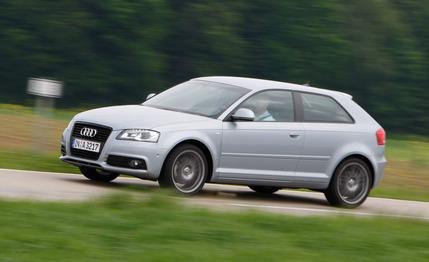
 First Drive Review
First Drive Review
Having broken the one-million-unit sales mark this March after just five years, Audi's premium compact A3 didn't need much fixing, but for 2009, Audi has brought the styling up-to-date and added content and options to its smallest offering.
Audi will continue to play conservative with the A3 in the U.S., channeling demand toward the high-volume A4 sedan. The A3 lineup here will be restricted to two variations from an extensive lineup that consists of eight engines and two body styles in its German homeland.
Although Europe gets three turbo-diesels and five gasoline engines in a three- or five-door package for the A3 (with the S3 there are six gasoline options), the U.S. will continue to be limited to the five-door, or Sportback, as it is known abroad. Engine choices for Americans consist of the 200-hp, 2.0-liter TFSI turbocharged inline-four—now available with Quattro and the dual-clutch S tronic transmission—and a 250-hp, 3.2-liter naturally aspirated V-6. The Quattro four-wheel-drive system is improved with a fourth-generation Haldex clutch that responds more rapidly.
These two engines are decidedly premium choices and are in keeping with the brand image. Unfortunately, North America does not get the hotter model—the 261-hp S3 with a 2.0-liter turbo four. Testing the performance S3 on the autobahn, where the governor kicks in well above the proclaimed 155-mph top speed, we had to watch our speedometer closely since it’s easy to reach triple digits as you suck up the straights. The limits set by the chassis are exceptionally high, and the stability-control system works so rapidly and discreetly that it manages to mask the car's tendency to understeer. Speed barely drops if the system kicks in for a quick correction.
Magnetic Ride’s Got Us Cornered—in a Good Way
We were duly impressed by the Audi Magnetic Ride adaptive shock absorbers supplied by Delphi. The semiactive suspension is already available on the TT; since both cars stand on the VW Group's ubiquitous PQ35 platform, it was adapted at reasonable cost. Unlike VW, Audi bases its active suspensions on sport suspensions, not standard suspensions. Thus, Audi Magnetic Ride provides the ultimate in cornering and stiffness—which posed a problem when trying to produce a noticeable amount of body roll at the behest of our photographer.
There was no V-6 available for evaluation, as there are no changes to the creamy and powerful 250-hp unit. With the 2.0-liter four gaining power and efficiency, we could see Audi dropping the six in the future, which would be a pity. But the fact of the matter is that although the V-6 manages to capture 20-to-30 percent of North American A3 sales, it accounts for only one-to-two percent of global sales. The more powerful S3, by contrast, accounts for five-to-six percent, and Audi expects the face-lifted Sportback to boost those figures, despite the S3's higher price.
The 2.0T for the U.S. is closely related to the S3, with a similar sporty sound and responsiveness. But above 100 mph, there is no contest. Our S3 tester hit the electronic ceiling at an indicated 167 mph, still wanting to pull faster, whereas the 200-hp TFSI struggled to reach its official 147-mph top speed.
Some of the less-powerful engine choices for Europe are interesting as well. The 2.0-liter turbo-diesels, newly fit with common-rail injection and rated at 138 horsepower and 168 horsepower, respectively, are remarkably torquey and quiet. The entry-level 104-hp, 1.9-liter turbo-diesel keeps the old-style unit injectors and is therefore noisier. But it is efficient: a low-drag version, called the 1.9 TDI e, manages 55 mpg.
As for the smaller gasoline units, the 158-hp, 1.8-liter gasoline TFSI (which means it is turbocharged) comes close to the 2.0T in feel and performance; the 101-hp, 1.6-liter naturally aspirated unit is clearly the budget choice and comes with commensurate low expectations. But the 123-hp, 1.4-liter TFSI is a downright disappointment. Lacking power and torque, it left us somewhat glum about the prospects of more downsized engines in the future.